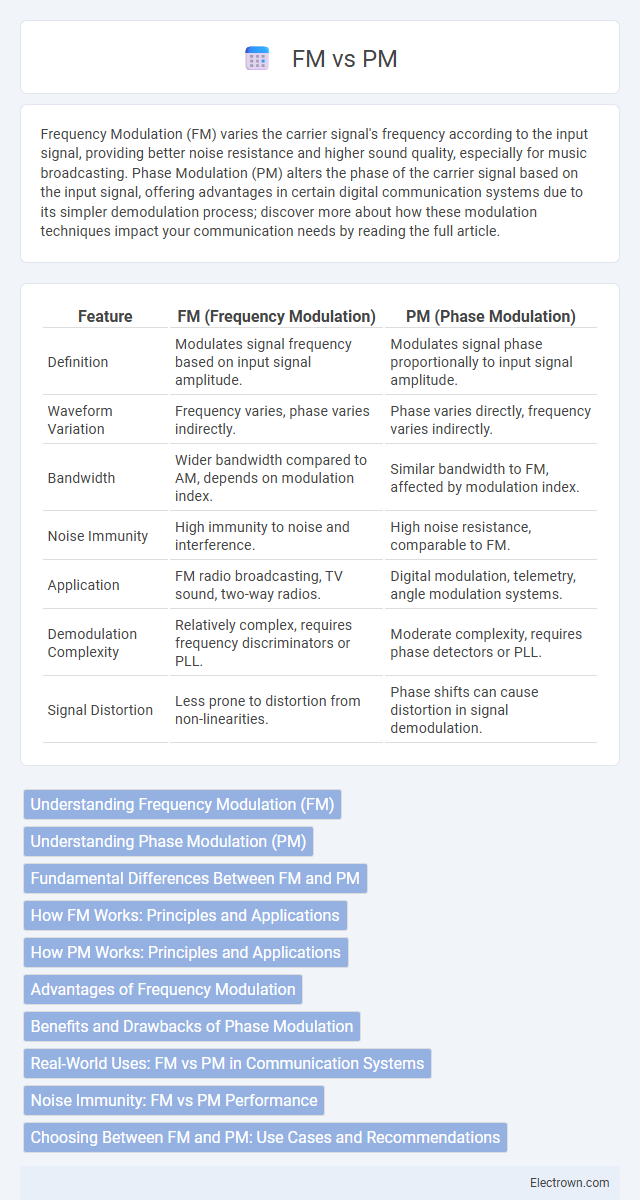Frequency Modulation (FM) varies the carrier signal's frequency according to the input signal, providing better noise resistance and higher sound quality, especially for music broadcasting. Phase Modulation (PM) alters the phase of the carrier signal based on the input signal, offering advantages in certain digital communication systems due to its simpler demodulation process; discover more about how these modulation techniques impact your communication needs by reading the full article.
Table of Comparison
| Feature | FM (Frequency Modulation) | PM (Phase Modulation) |
|---|---|---|
| Definition | Modulates signal frequency based on input signal amplitude. | Modulates signal phase proportionally to input signal amplitude. |
| Waveform Variation | Frequency varies, phase varies indirectly. | Phase varies directly, frequency varies indirectly. |
| Bandwidth | Wider bandwidth compared to AM, depends on modulation index. | Similar bandwidth to FM, affected by modulation index. |
| Noise Immunity | High immunity to noise and interference. | High noise resistance, comparable to FM. |
| Application | FM radio broadcasting, TV sound, two-way radios. | Digital modulation, telemetry, angle modulation systems. |
| Demodulation Complexity | Relatively complex, requires frequency discriminators or PLL. | Moderate complexity, requires phase detectors or PLL. |
| Signal Distortion | Less prone to distortion from non-linearities. | Phase shifts can cause distortion in signal demodulation. |
Understanding Frequency Modulation (FM)
Frequency Modulation (FM) encodes information by varying the frequency of a carrier wave in direct proportion to the input signal, allowing for high-quality sound transmission with reduced noise interference. FM is widely used in radio broadcasting, two-way radios, and audio synthesis, offering better fidelity compared to Amplitude Modulation (AM) due to its resilience against signal amplitude variations. Your ability to grasp FM fundamentals enables better comprehension of wireless communication technologies and improves application in fields like broadcasting and telecommunications.
Understanding Phase Modulation (PM)
Phase Modulation (PM) varies the phase of the carrier signal in direct proportion to the instantaneous amplitude of the modulating signal, enhancing signal robustness against noise. Unlike Frequency Modulation (FM), which modifies the carrier frequency, PM alters the phase angle, making it highly effective in digital communication systems such as PSK (Phase Shift Keying). Understanding PM helps you optimize data integrity in wireless transmissions by leveraging its efficient bandwidth usage and lower susceptibility to amplitude distortion.
Fundamental Differences Between FM and PM
Frequency Modulation (FM) varies the carrier wave's frequency in direct proportion to the input signal, while Phase Modulation (PM) changes the phase angle of the carrier signal according to the modulating signal. FM provides better noise immunity and is widely used in radio broadcasting, whereas PM is commonly employed in digital synthesizers and communication systems for its sensitivity to phase shifts. Understanding these fundamental differences helps optimize your choice of modulation technique based on signal requirements and application contexts.
How FM Works: Principles and Applications
Frequency Modulation (FM) works by varying the frequency of the carrier wave in direct proportion to the amplitude of the input signal, enabling precise transmission of audio and data. This principle ensures superior noise resistance and signal clarity, making FM ideal for radio broadcasting, two-way radios, and high-fidelity audio systems. Understanding how FM works can help you choose the right modulation technique for applications requiring stable and clear signal transmission.
How PM Works: Principles and Applications
Phase Modulation (PM) works by varying the phase of the carrier signal in direct proportion to the instantaneous amplitude of the modulating signal, effectively encoding information within the phase shifts. This technique is widely used in applications such as telemetry, radar systems, and digital communication protocols like Wi-Fi and Bluetooth, where resistance to noise and signal distortion is critical. The ability of PM to maintain signal integrity over long distances and through various interference environments makes it essential for maintaining reliable data transmission in complex networks.
Advantages of Frequency Modulation
Frequency Modulation (FM) offers superior noise immunity compared to Phase Modulation (PM), making it ideal for high-fidelity audio transmissions and broadcasting. FM signals maintain better signal-to-noise ratios, especially in environments with electromagnetic interference, ensuring clearer reception. Your communication system benefits from FM's resistance to amplitude variations, which enhances overall signal quality and reliability.
Benefits and Drawbacks of Phase Modulation
Phase modulation (PM) offers benefits such as improved noise immunity and better spectral efficiency compared to frequency modulation (FM), making it ideal for digital communication systems. However, PM's sensitivity to rapid phase changes can lead to signal distortion and complexity in demodulation processes. The trade-off between enhanced bandwidth utilization and increased implementation complexity defines PM's suitability in various applications.
Real-World Uses: FM vs PM in Communication Systems
FM (Frequency Modulation) is widely used in high-fidelity radio broadcasting, owing to its resilience to signal noise and better sound quality. PM (Phase Modulation) is crucial in digital communication systems such as satellite transmission and Wi-Fi, where precise phase shifts enhance data integrity and transmission efficiency. Your choice between FM and PM influences the reliability and clarity of communication depending on the application requirements.
Noise Immunity: FM vs PM Performance
Frequency Modulation (FM) exhibits superior noise immunity compared to Phase Modulation (PM) due to its ability to maintain signal integrity amid amplitude variations and external interference. FM's constant amplitude waveform makes it less susceptible to amplitude noise, resulting in clearer signal reception, especially in environments with high electromagnetic interference. Conversely, PM, while effective in certain applications, often experiences greater signal degradation when exposed to noise, as its phase variations can be more easily disrupted.
Choosing Between FM and PM: Use Cases and Recommendations
Frequency Modulation (FM) offers superior noise resistance and is ideal for high-fidelity audio transmissions, such as music broadcasting and two-way radio communications. Phase Modulation (PM) provides better spectral efficiency, making it suitable for digital data transmission and satellite communication systems. You should choose FM for applications requiring audio clarity and PM for scenarios demanding efficient bandwidth usage and digital signal integrity.
FM vs PM Infographic

 electrown.com
electrown.com